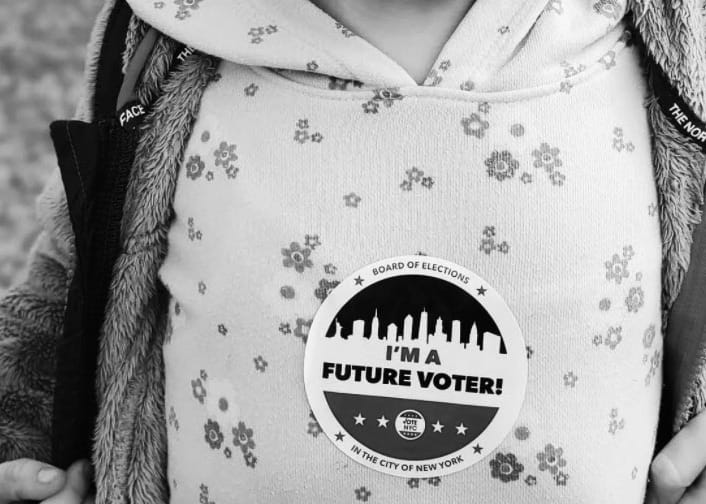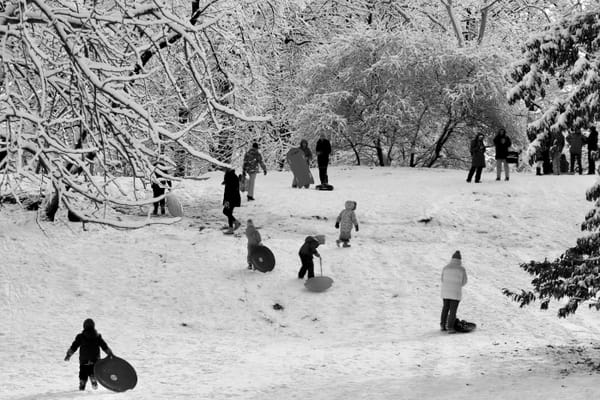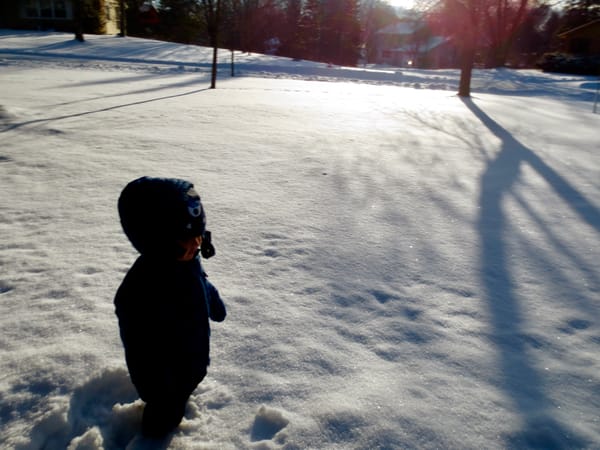Take Your Children into the Voting Booth
Because hope requires resilience and determination

A Reminder from Smaller Beings
The bird building her home on your windowsill
has had every nest destroyed before.
The spider that is delicately weaving a silken masterpiece
has had every single thread broken before.
And despite it all,
they try again.
~Nikita Gill
I have vivid memories of voting long before I could vote myself. I imprinted memories that I can still slip back into easily, long before I was tall enough to actually reach all the little metal switches that needed to be flipped to cast a ballot. (Remember those voting machines full of switches and levers?! I loved them. They broadcast the importance of their job.)
I remember waiting in line next to my dad and being struck by the fact that the room we were standing in was usually used for something entirely different. The temporariness of it was intriguing to me at an age when sharing space was so central to my developmental moment. When every other important experience seemed to have its own defined place, voting happened in borrowed rooms. In order for anyone to do this important thing, someone had to say: yes, everyone is welcome in our school, our church, the lobby of our home.
The poll workers directing people and presiding over the book where voters signed their names also fascinated me. Most of them were older, retired women, many of whom were clearly volunteers. Unlike the rest of life, which was populated by people doing their jobs and filling the predictable roles that they filled each and every day, this most official experience seemed largely facilitated by goodwill.
I also remember the formality and kinesthetic significance of it all. Much of this is different now that the ballots are different. But, at the time, the curtain that wrapped the voting booth in privacy, the metal switches that audibly clicked as they were flipped, and the long lever that registered the vote all lent a palpable air of importance to the process. It felt vital and a little exciting.
I have an equally visceral but very different memory of voting the first time my role was reversed and I was the parent casting my own ballot, instead of the child along for the ride. In 2012, I stood in line in the basement of a Harlem apartment building for what I think was several hours with my then one-year-old strapped to me in a cloth carrier, trying to keep him occupied while the line snaked around hissing pipes and past a utility sink. As a white woman living in a non-swing state, but voting for a Black presidential candidate in a predominantly Black and Dominican neighborhood, it’s the only experience of voting I’ve ever had that felt designed to discourage my neighbors from casting their ballots. I have no idea what circumstances or decision actually led to that strange, dark basement being selected as a polling site, but we all stuck the wait out together, nonetheless.
In 2016, I stood in another long line with my kindergartener, who no longer needed to be strapped to my body to participate. He was shockingly patient, filled—even at five years old—with the exuberant awareness that we were doing something important. And in 2020, I stood in the longest line I’ve ever stood in. Masked and distanced, we wrapped ourselves around a city block. A local man on a small motorcycle, with a microphone and an amplifier strapped to the back, moved around the block, stopping periodically to sing to different portions of the line, serenading our collective determination. I didn’t bring my son with me that year, because in 2020, in addition to the many hours of waiting I knew were in store, we were also consumed with managing risk and limiting time spent in crowds. He has accompanied me to countless local elections as well between that first Harlem basement and now, waiting in churches and cafeterias and even in the nursing home down the block from our apartment a few times.
The voting process feels less ceremonial than it did when I was a child. The curtain and the satisfying switches and levers are relics of the past. But I hope the significance of the act has been planted equally firmly in his memory, even without these formalities.
Voting isn’t the only action required of citizenship. Progress demands so many other lessons, which we need to embed every day, as we educate our children to be informed, thoughtful, deep thinkers with committed, compassionate hearts and energetic, purpose driven spirits. It is tempting to view some of these qualities as innate traits of youth. But it’s surprisingly easy for us all, including children, to become jaded, discouraged, and disengaged, particularly in disorienting, fear driven times.
Last week, I wrote about the commitment and engagement of Gen Z, but I worry a little more about the generation on its heels. Many in Gen Z grew up in a financial crisis but came of age in the recovery from that crisis. The first election they viscerally remember was likely 2008, when “hope” was the anthem of the day. Many in Gen Z had the wind knocked out of them in 2016, but they rose immediately and have since become part of a powerful resurgence of activism across a multiplicity of issues. They see a broken world and are driven to correct past failures, because they’ve had an arc of life experience that has been challenging, for sure, but has also been peppered with formative moments of optimism realized, and with the rush of participating in empowered collective action.

By contrast, many in Gen Alpha spent a significant portion of their early education buffeted by the pandemic. For those in the older half of this cohort, who have been through one or two election cycles already, every election they’ve borne witness to has felt vitriolic, existential, and at times the democratic process has erupted into horrifying violence. They’ve seen the rise of disinformation as well as some shockingly fierce blowback to the activism of Gen Z.
Within five years, Gen Alpha will comprise the entire primary and secondary education system.
It’s early to have meaningful data on this group, but there are hopeful signs. Those observing generational trends have noted that they appear to be resilient, flexible, independent, highly creative, and globally minded. These traits make sense in the scope of their unusual early life, which has demanded unique levels of resilience and creativity. But I also worry that if they keep witnessing hope thwarted, they will become increasingly reluctant to engage in the kind of active, powerful citizenship we’ve observed in their closest generational peers. We need to take great care to nurture the spirit of engagement among this generation of children—to ensure that their form of resilience remains one that is marked by a willingness to stay open-hearted, creative, kind, and participatory, even when the world feels bleak. The alternative is a resilience that is marked by thick skin and disaffection instead, and I don’t think we can afford that, nor do they deserve it.
As with everything in parenting and teaching, the first step in holding this generation and guiding them through delicate moments is modeling. We have to create the circumstances that allow them to see that there can be joy in the process of working for a better world, and we have to show them that we are willing to keep coming back and striving for a better world even when things don’t feel joyful.
So, if you have one of the littlest members of Gen Alpha in your life, strap them to your body and bring some cheerios along to keep them busy while you stand in line, wherever that line may be. If they are old enough to stand next to you, hold their hand and talk about why this is an important and special thing to be able to do. Even if it seems boring and unglamorous, it is something that many of us have not had the right to do for very long within the scope of history. If they’re edging past your shoulders and looking ahead to casting their own ballots in a few years, talk about the stakes of this particular election for their future—they have thoughts to share. And talk about the people who are volunteering to put themselves on the line in newly risky ways to check addresses, direct people to the correct line, hand out ballots and stickers, and count votes. Most importantly, talk about the reasons you come back to do this again and again. Show them how you keep your heart open and filled with hope, even when the world doesn’t make it easy.
Voting is one of the most hopeful things we do, not only because we cast our vote believing in the possibility of a particular outcome, but also because it is something we must constantly return to again and again, no matter the outcome. And that is a lesson we need to live actively, hand in hand with a generation of children who have experienced more than their fair share of disappointment and fear. Voting isn’t the only step in teaching citizenship, but it’s an important first step, and it’s one we can take together.
Wishing you hope and determination,
Alicia
P.S. If you haven’t voted yet and need to check your registration or find your polling site, make a voting plan here.
P.P.S. If you live in New York and want to avoid long lines, check the wait time at your polling site here. This is especially helpful if you are taking a child with you to vote!
If you think someone else in your life might enjoy reading Notes on Hope, please share. It’s always easier to hold onto hope when we’re not doing it alone.





